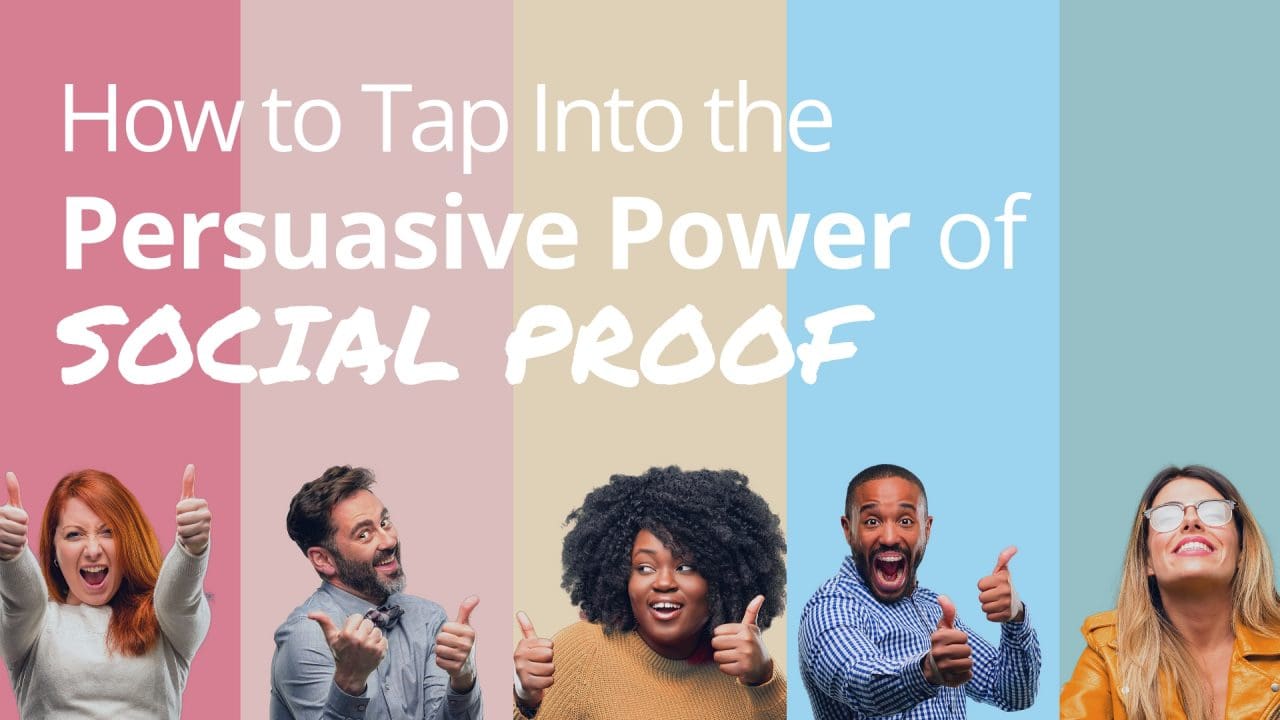How to Leverage the Persuasive Power of Social Proof

When your prospects are facing the decision of whether to work with you, seeing that others have made that same decision can be very helpful.
Psychologists call this concept consistency theory or congruency theory. Another term you see used in relationship to social proof is confirmation bias. While a purist could argue that these are all slightly different concepts, there’s no mistaking that they are at least kissing cousins.
Social Proof Hits the Core of Your Prospects’ Decision Making
Antonio Demasio is a famed neuroscientist who has determined that every decision humans make is emotional at its core.
Using technology known as Magnetic Resonance Tomography, Demasio studied subjects who, due to damage to their brain, were not able to feel emotion. These same subjects were, therefore, unable to make decisions.
The ability to feel emotion is at the core of any decision!
This knowledge of how people make decisions compels us to make sure we attend to that part of the decision-making process.
This is why appealing to solving a problem or taking advantage of an opportunity must be at the core of much of our value messaging.
This is why we always prefer in-person appointments to over-the-phone appointments.
This is why a video conference call is better than just a regular phone call.
The stronger the personal connection that you are able to make with anyone, the more you will be able to influence them and compel them to act upon your request – whatever that request might be.
Social Proof is a Form of Evidence
If you sell services, you are probably emphasizing the relationships you build with your clients. And you should.
You’re selling an intangible; therefore, you are in the evidence business. Showing your prospects that others are doing what you would like them to do can be compelling evidence for most people.
Here’s the bottom line.
If you have prospects, clients, or centers of influence with a neutral view toward you (if that’s even possible), then the right social proof can move them into a positive view of you. If they already view you in a positive light, then social proof will strengthen their positive perceptions.
6 Types of Social Proof /Evidence You Should Be Using
1. Referrals & Introductions
You know I had to start here – right? After all, I’ve dedicated a quarter century (wow that sounds like a very long time) to helping businesses acquire more ideal clients through referrals and introductions.
This is probably the highest form of social proof, because someone who knows your value and likes you has taken the time and energy to introduce others they care about to you.
Of course, the stronger the level of trust between the referral source and the prospect, and the higher the quality of introduction, the more effective this piece of evidence becomes.
Someone has experienced your value and recommends you. Sometimes, that’s all the social proof you need. The rest becomes a fait de complet (that’s French for “done deal).
2. Case Studies
A case study can be a very significant piece of evidence, because it can go into the kind of depth not possible with a simple testimonial.
If you must, you can keep your case studies anonymous. However, if you’re able to use the names of all the players, the business name, and even photos – that’s the strongest way to go.
A good case study has these four cornerstones upon which to build:
- The problem that needs fixing or the opportunity that wants to be achieved.
- Other related challenges or opportunities that come into play in reaching the desired outcome.
- The actions taken by you, your clients, and other characters in this “play.”
- The results produced.
Case studies can also be particularly effective in your courtship of centers of influence – those who have the ability to introduce you to ideal clients, but may not have experienced your value first hand. Problems solved. Opportunities achieved. These bring your value proposition to light in a powerful way.
3. What You Write
It is my contention that “experts speak and experts write.” By definition, an expert is “a person who has a comprehensive and authoritative knowledge of or skill in a particular area.” YOU are an expert.
Writing blogs, white papers, books – you name it – will help you build a body of evidence that demonstrates your expertise.
But, don’t just write these things hoping that people will see them. Promote what you write to prospects and clients – as a way to provide tangible value, establish credibility, AND provide your referral sources with tools that they can use when introducing you.
For example, when I learn of someone who wants to introduce me to a colleague, I frequently ask, “Would you like me to send a copy of one of my books to you to give to them?” If they are introducing me to a committee, I’ll send as many books as needed.
No book? No worries. I know one team of financial advisors who had an article published in a prestigious magazine. They leverage that piece in as many ways as possible.
At the risk of being redundant (not to mention repeating myself ????), these pieces that you write allow you to reach out to people leading with value; they establish your relevant credibility – moving people to action, and they provide your clients/ centers of influence with tools that will help them feel comfortable introducing you to others.
“She/He wrote the book on ___________.”
4. Speaking to Groups
As with writing, speaking to groups of prospects or influencers can be a powerful dose of evidence. Not only do you establish your credibility, you also connect with people in a way that you just can’t through a written piece.
Research has demonstrated that every decision humans make are emotional at their core.
This knowledge of how people make decisions compels us to make sure we attend to that part of the decision process. This is why we always prefer in-person appointments over phone appointments. This is why a video conference call is better than just a regular phone call.
The stronger the personal connection that you are able to make with anyone, the more you will be able to influence them and compel them to act upon your request – whatever that request might be.
3 Tips for Speaking to Prospects:
- Educate – Bring good information. Take counterintuitive stands on topics to grab their attention. Use statistics from time to time to emphasize a point. Yes! Statistics can actually create an emotional response!
- Entertain – I’m not talking singing, dancing, or telling jokes. Just let whatever authentic sense of humor you have shine through. No sense of humor? Really? Maybe you can find a few photos or cartoons (with permission, please) to use to make a point and inject some humor. Laughter opens the heart. (Emotional response)
- Entice – Tell people what they need to do. Give them some of the “how they can do it.” And then have a call to action (suggested next step) so they can take full advantage of your expertise.
5. Testimonials
Testimonials are closely related to referrals and introductions, because you have someone whom your prospects can relate to (the more similar to them, the better) saying something positive about you and your value proposition.
Financial professionals are often not permitted to use most types of testimonials (even including endorsements on social media platforms). The financial services sector of our economy is heavily regulated, and since some bad actors have made false claims over the years, the industry has been compelled to keep things on the “safe side.”
If you are able to use testimonials, then please do so often. Here are a few tips:
- Video testimonials are the most powerful due to the energy that is conveyed in a video. But, make these short (20-30 seconds in most cases).
- No video? Use the person’s photo. The more real and personal you make these, the more impact they will have.
- If at all possible, use the person’s name, title, and location. Again, the more real and personal the more effective.
- Do your best to make testimonials speak to specific attributes about working with you and/or results you helped produce. If you can’t promote financial results, you can promote your ability to help your clients gain clarification and confidence.
- Take a proactive approach toward collecting testimonials. Just like referrals and introductions, you can take a passive approach or be appropriately proactive. Which do you think will serve you better?
6. Social Event Marketing
Earlier, I mentioned Congruency Theory and the related terms of Confirmation Bias and Consistency Theory.
If there is one place where you can truly capitalize on those concepts, it’s with Social Event Marketing.
When your clients who like and trust you get together with other clients who like you and trust you, the net result is that they all leave the event liking and trusting you even more. This helps you develop client engagement and business friendships.
Now… when a few prospects and/or centers of influence attend one of these love fests, they get a heavy dose of social proof. They see how you and your clients relate to one another.
Would you like more ideal clients? Invite your ideal prospects to attend social events that you host for a few of your ideal clients. When your clients discover your guests (and yes, it’s okay to introduce your guests as such to your clients), your clients will say good things about you. Voila! Just the evidence they need to trust their gut and move forward in working with you.
NOTE: Generally speaking, you should favor smaller events. The point of a client-appreciation event or a bring-a-guest event, is to make connections. The more people, the thinner the connections.
Every business is an Evidence Business. And, since Social Proof speaks to the emotions, it should be a powerful piece in your efforts to compel action on the part of your prospects and clients.
You May Also Like:
How to Use Breakfast Meetings to Meet More Prospects Face-to-Face
 \
\


